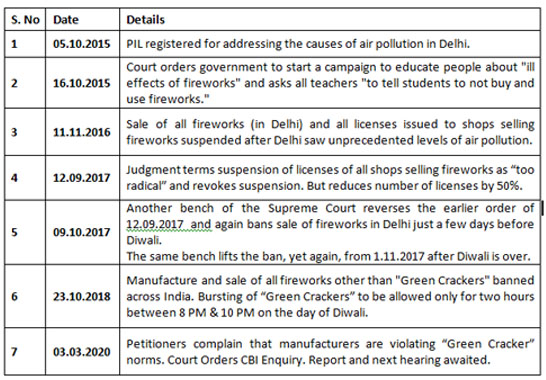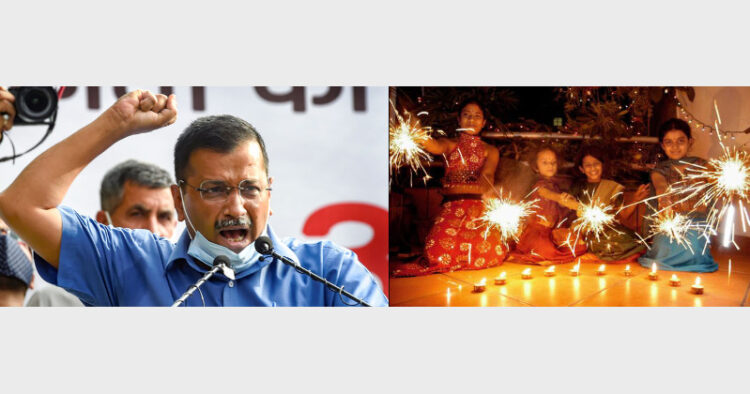Crackers, especially those burst around Diwali, and the extent of pollution caused by them, have become subjects of an intense debate in the last few years. Given the amount of analysis and dissection already done on the subject, including that done in the Hon’ble Supreme Court of India, it is rather surprising to note that several key issues have not yet been brought to the fore in public discourse.
This write-up, planned as a series of 5 distinct articles, attempts to bring some of these hitherto untouched issues to light and also provide definitive answers to the questions raised, with the backing of all data, facts, and reasoning.
The broad outline of the issues, as they shall be covered in each part of this series, is given as under:
- How a case against air pollution in NCR Delhi transform into a case obsessed with banning crackers across India?
- Do crackers cause pollution? What the data tells us. Analysis of 5-year data for Delhi.
- Analysis of Supreme Court’s judgment and issues arising from it.
- Analysis of “Precautionary Principle” – a key justification given for banning crackers.
- How other nations handle fireworks – and Conclusion.
The first of the above topics for this write up:
How did a case against air pollution in Delhi, end up banning crackers across India?
To understand the above, let’s first look at the timeline of the case in Supreme Court. See table given below:
Crackers, especially those burst around Diwali, and the extent of pollution caused by them, have become subjects of an intense debate in the last few years. Given the amount of analysis and dissection already done on the subject, including that done in the Hon’ble Supreme Court of India, it is rather surprising to note that several key issues have not yet been brought to the fore in public discourse.
This write-up, planned as a series of 5 distinct articles, attempts to bring some of these, hitherto untouched issues to light and also provide definitive answers to the questions raised – with the backing of all data, facts and reasoning.
The broad outline of the issues as they shall be covered in each part of this series, is given as under:
- How a case against air pollution in NCR Delhi transformed into a case obsessed with banning crackers across India?
- Do crackers cause pollution? What the data tells us. Analysis of 5-year data for Delhi.
- Analysis of Supreme Court’s judgment and issues arising from it.
- Analysis of “Precautionary Principle” – a key justification given for banning crackers.
- How other nations handle fireworks – and Conclusion.
The first of the above topics for this write up:
How did a case against air pollution in Delhi, end up banning crackers across India?
To understand the above, let’s first look at the timeline of the case in Supreme Court. See table given below:

Few Points worth noting from the above summary and detailed study of judgments are:
- While the petition ostensibly was for addressing “causes of Air Pollution,” the petitioners and the Hon’ble Supreme Court both seem to have focussed almost exclusively on regulating fireworks.
- The focus on banning fireworks is such that no other cause of “Air Pollution” seems to have even been discussed (to any significant extent), investigated or acted upon as a part of the Court proceedings in this case.
- The Court from the very beginning seems to have been inclined against fireworks as can be inferred from the order of 16.10.2015 wherein it ordered the govt to give wide-publicity to the “ill-effects of fireworks” even as the hearing of the case had just begun and no substantive or scientific data was made available to it.
- The Court has been led to believe that there is a prevailing “national consensus” in the country in favour of banning use of fireworks for Diwali across India.
- The final nail, however, in the opinion of the author, seems to have been driven by the submissions made by the Ministry of Environments, Forests and Climate Change (MoEFCC), which concurred with the prevailing consensus and proposed the use of “Green Crackers” as a means of “reducing pollution.”
- The last judgment pronounced by the Hon’ble Supreme Court on 23.10.2018 is largely an acceptance of the recommendations given by MoEFCC.
It would thus seem like the petitioners in the case have used the larger cause of mitigating “air pollution” in Delhi as a mere cloak to cover the real intent of getting fireworks banned across India. What their reasons are for wanting such a ban, what are their motivations and how funds were arranged to afford top most lawyers like Abhishek M. Singhvi, Kapil Sibal and K.K. Venugopal (he was not the attorney general of India then) are subjects of speculation in which the author would not like to indulge.
That said, another important fact borne out form the points listed above is that the Government of India, through MoEFCC, seems to have supported the interventions of the Hon’ble Supreme Court of India in this case. It may seem a bit difficult to digest for many, especially with BJP in power for the duration of this case, but the fact remains that restrictions being placed on the bursting crackers at the time of Diwali are not because of an unwarranted intrusion by the judiciary into the domain of the executive but rather because of an agreement between both the judiciary and the government.
Whether the people of the country are in agreement with their judiciary and government or not is different matter all-together.
*****
Coming up in the next part – Do crackers cause pollution? Definitive answers with an analysis of the pollution data of Delhi for the last 5 years.
Diwali, Crackers and Pollution – Truth uncovered! Part 5 – How other nations handle fireworks



















Comments